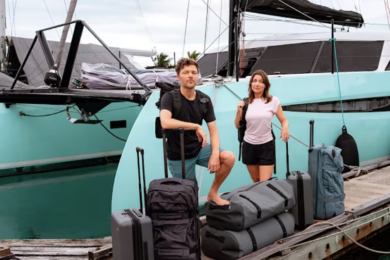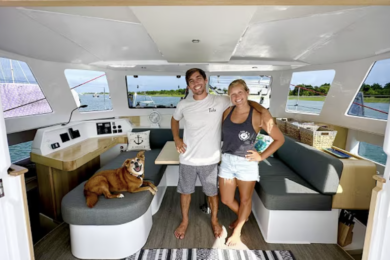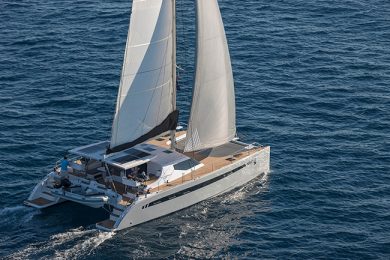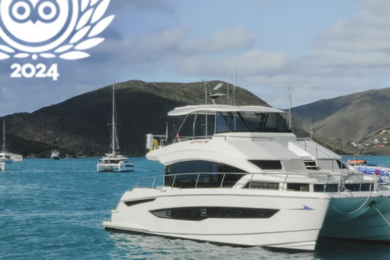An in-depth look at bridgedeck clearance for catamarans (Published Summer 2009)
Bridgedeck clearance (the height of the bridgedeck above the water) is crucial for catamaran seaworthiness and crew comfort at sea. Because bridgedeck clearance can be seen at a glance, and is easily measured, even an inexperienced sailor can evaluate it. The purpose of this article is to equip the reader with the tools to do so.
Why does a catamaran need high bridgedeck clearance? First, ocean waves need headroom to pass between the hulls. Second, each bow creates a bow wave; these V-shaped waves meet under the bridgedeck and increase the clearance needed.
What happens when bridgedeck clearance is inadequate? The one-word answer: Pounding.
Pounding causes three problems: to the crew, physical discomfort and fatigue; to the boat and rig, excessive wear and tear (I’ve had bulkheads break from windward pounding); and to the boat speed, a serious reduction. The potential of the catamaran hull form, which is so impressive when sailing at 8 to 10 knots in 20 knots of breeze in protected waters, can be quickly reduced to 5 knots by pounding. Yes, a very low bridgedeck cat can lose 3 to 4 knots of boat speed with a major pound. Then over the next minute or two, the speed will slowly climb back up to 8 to 9 knots, then Slam! Bang! another pounding, and you are back to 4.5 knots. Now, if you are not planning to make offshore passages—and let’s face it—most catamarans never do, then all this is a moot point. But for passagemakers, it is vital. Off Brazil, I met delivery crews of cats en route to Florida. Some swore they would never deliver another cat again. Yet the subsequent owners of these vessels may be very happy with them, because they sail only in protected waters. But if you are heading offshore, caveat emptor.
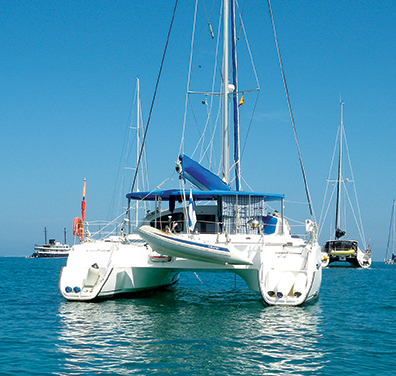 If you are looking for a sea kindly and seaworthy catamaran, be aware that the typical protected-waters, fair-weather test-sail conducted by you or a yachting magazine, reveals almost nothing about the boat’s potential offshore. Pounding can and will make any of the following activities difficult: moving around the boat, navigating, sail-handling, using the head, cooking, eating, resting, reading and sleeping. It must be added that when sailing downwind, the ill effects of low bridgedeck disease are greatly mitigated. Because the boat is going in the same direction as the waves, pounding, crew fatigue and speed loss are much less, to the point where the crew might think that bridgedeck clearance is not that important. You may be one of the lucky few for whom the winds cooperate, but for most of us this is not the case. Headwinds happen even when the pilot charts say otherwise; our offshore passages are not all downwind, and therefore we require our vessel to be seaworthy and sea kindly on all headings. This is nicely put by one builder’s slogan: “We can demand nothing from the sea, therefore we must demand everything from our boat.”
If you are looking for a sea kindly and seaworthy catamaran, be aware that the typical protected-waters, fair-weather test-sail conducted by you or a yachting magazine, reveals almost nothing about the boat’s potential offshore. Pounding can and will make any of the following activities difficult: moving around the boat, navigating, sail-handling, using the head, cooking, eating, resting, reading and sleeping. It must be added that when sailing downwind, the ill effects of low bridgedeck disease are greatly mitigated. Because the boat is going in the same direction as the waves, pounding, crew fatigue and speed loss are much less, to the point where the crew might think that bridgedeck clearance is not that important. You may be one of the lucky few for whom the winds cooperate, but for most of us this is not the case. Headwinds happen even when the pilot charts say otherwise; our offshore passages are not all downwind, and therefore we require our vessel to be seaworthy and sea kindly on all headings. This is nicely put by one builder’s slogan: “We can demand nothing from the sea, therefore we must demand everything from our boat.”
Why are so many bridgedecks too low?
As a general rule, the higher the bridgedeck is off the water, the better. So why don’t all cats have high bridgedeck clearance? Simply put, providing more clearance results in reduced interior headroom and boat aesthetics, and more windage. We can assume the designer knows the importance of adequate bridgedeck clearance, but in order to sell his design to a builder, he has to accommodate the builder’s wishes. The builders know that what sells boats is a large, airy saloon with full headroom, so they keep asking the designers for more headroom even though it means less bridgedeck clearance. At the boat show, the buyer is impressed by the spacious saloon with full headroom, but does not notice the low bridgedeck. The builder makes a sale, while the lower-headroom, higher-bridgedeck cat on the next pontoon remains unsold. It all boils down to marketing.
 Many catamarans are designed for the charter market. They are built not for crossing oceans, but to accommodate as many charter guests as possible. This means lots of staterooms with full-size berths and en-suite heads, a large saloon and cockpit (long bridgedeck), and easy access down into the hulls. Usually, the corollary of all this is a long, low bridgedeck and protuberances into the tunnel. Such a vessel may be fine for the charter market (reaching between the Caribbean islands) but is much less suitable for blue-water cruising. Other boatyards build vessels with the passagemaking private owner in mind, and most of these have fewer en-suite staterooms and more bridgedeck clearance.
Many catamarans are designed for the charter market. They are built not for crossing oceans, but to accommodate as many charter guests as possible. This means lots of staterooms with full-size berths and en-suite heads, a large saloon and cockpit (long bridgedeck), and easy access down into the hulls. Usually, the corollary of all this is a long, low bridgedeck and protuberances into the tunnel. Such a vessel may be fine for the charter market (reaching between the Caribbean islands) but is much less suitable for blue-water cruising. Other boatyards build vessels with the passagemaking private owner in mind, and most of these have fewer en-suite staterooms and more bridgedeck clearance.
 Some designers think that most pounding occurs forward, so try to have more clearance forward. Others think that most pounding occurs aft, so try to have more clearance aft. I think that all designers would agree that the larger the boat, the easier it is to provide both adequate bridgedeck clearance and interior headroom, while keeping nice aesthetics and low windage.
Some designers think that most pounding occurs forward, so try to have more clearance forward. Others think that most pounding occurs aft, so try to have more clearance aft. I think that all designers would agree that the larger the boat, the easier it is to provide both adequate bridgedeck clearance and interior headroom, while keeping nice aesthetics and low windage.
The adverse effects of a low bridgedeck can be somewhat mitigated by curving the hull-to-bridgedeck join (this is not necessary if the bridgedeck is high), so waves get deflected or curled around instead of slamming onto a flat surface. Other designers add a nacelle on the centerline, which can help split waves and provide additional buoyancy forward in heavy weather, but the nacelle must not be too low.
 Be wary of bridgedecks where the leading edge is flattish and steep (45 degrees to near vertical). The leading edge should be low profile and sloped so it does not present a flat surface to oncoming waves.
Be wary of bridgedecks where the leading edge is flattish and steep (45 degrees to near vertical). The leading edge should be low profile and sloped so it does not present a flat surface to oncoming waves.
Can a catamaran have too much bridgedeck clearance? Not as far as the waves are concerned, but there are reasons not to go too high. Height creates more windage, which makes it tricky to dock the boat. It also makes it harder for the crew to board the vessel from a dock. Excessive windage makes slow-speed maneuvering difficult. More importantly, it can jeopardize the vessel’s ability to claw off a lee shore. In heavy winds, sails must be reefed, but the high windage remains. If the leeway from the windage is greater than the windward ability developed from the reefed sails, the vessel may not get off the lee shore. A high bridgedeck also raises the center of gravity, which reduces stability and induces pitching. Like anything else on a boat, a compromise is needed. Unfortunately, the compromising gets harder as the boat gets smaller.
Is there a rule of thumb for bridgedeck height? I propose the following:
LOA (in feet) x 0.7 = Minimum Bridgedeck Clearance (in inches)
For example, for a 45-foot cat: 45 x 0.7 = 31.5 inches.
If the vessel has a wide beam (greater than one half the length overall), additional bridgedeck clearance is needed. Imagine a catamaran beam on to the seas. The further the hulls are apart, the lower the hulls will ride on the shoulders of the wave—and the higher the crest will be between them. If the beam is greater than one half the LOA, then one should consider a second rule of thumb:
Minimum Bridgedeck Clearance = 20 percent of span between hulls
For example, a 45-foot cat has a beam of 25 feet. The hulls are five and a half feet wide so we have:
25 – 5½ – 5 ½ = 14 (14 x 12 =168 inches) — the span between hulls. 20 percent of 168 = 33.6-inch clearance.
If the beam is less than one half LOA (many older cats fall into this category), then less bridgedeck clearance is acceptable.
Protuberances
 On many catamarans, lumps protrude into the tunnel between the hulls. These can severely degrade the vessel’s seaworthiness, depending upon their shape, size and location. A vessel that has reasonable or good clearance on the centerline may pound badly, due to protuberances into the tunnel. For example, to provide double berths in the aft staterooms, the hulls aft are widened to extend into the tunnel, at a height of a few inches to a foot above the waterline—pounding guaranteed, right next to your head when you are trying to sleep. To provide more interior volume in the hulls amidships and in the forward cabins, “shelves” are often added. These shelves extend from near the bows, all the way aft along the inside of the hulls, typically six to 12 inches above the waterline. To get from bridgedeck level down to the hull accommodations, gentle stairways are preferred over the steep companionway steps found in monohulls. But such stairways protrude into the tunnel, and waves pound on them at sea. On smaller vessels (30 to 36 feet), it is hard to provide standing headroom on the bridgedeck. As a compromise, the designer may make a standing headroom passageway at the aft end of the saloon, connecting the two stairways down into the hulls. To achieve this, he drops the bridgedeck by six to eight inches in the passageway. The forward face of this gets hit by taller waves.
On many catamarans, lumps protrude into the tunnel between the hulls. These can severely degrade the vessel’s seaworthiness, depending upon their shape, size and location. A vessel that has reasonable or good clearance on the centerline may pound badly, due to protuberances into the tunnel. For example, to provide double berths in the aft staterooms, the hulls aft are widened to extend into the tunnel, at a height of a few inches to a foot above the waterline—pounding guaranteed, right next to your head when you are trying to sleep. To provide more interior volume in the hulls amidships and in the forward cabins, “shelves” are often added. These shelves extend from near the bows, all the way aft along the inside of the hulls, typically six to 12 inches above the waterline. To get from bridgedeck level down to the hull accommodations, gentle stairways are preferred over the steep companionway steps found in monohulls. But such stairways protrude into the tunnel, and waves pound on them at sea. On smaller vessels (30 to 36 feet), it is hard to provide standing headroom on the bridgedeck. As a compromise, the designer may make a standing headroom passageway at the aft end of the saloon, connecting the two stairways down into the hulls. To achieve this, he drops the bridgedeck by six to eight inches in the passageway. The forward face of this gets hit by taller waves.
The worst protuberances are those that present a steep, flat surface facing forward. Waves collide with such surfaces head-on, and this creates the worst pounding. Protuberances that are streamlined are less detrimental.
Why are so many bridgedecks too long?
 Besides bridgedeck clearance, the length of the bridgedeck is important. Other things being equal, hulls with the weight concentrated toward the center of the boat will pitch less than those of the same weight but with the weight more toward the ends. What this means in practice is that the bridgedeck should be kept as short as possible. Yet take a stroll down the pontoons at a boat show, and you will see many cats where the bridgedeck is carried so far aft that the hull sterns hardly extend aft of the cockpit. Others have a solid foredeck that almost reaches the bows.
Besides bridgedeck clearance, the length of the bridgedeck is important. Other things being equal, hulls with the weight concentrated toward the center of the boat will pitch less than those of the same weight but with the weight more toward the ends. What this means in practice is that the bridgedeck should be kept as short as possible. Yet take a stroll down the pontoons at a boat show, and you will see many cats where the bridgedeck is carried so far aft that the hull sterns hardly extend aft of the cockpit. Others have a solid foredeck that almost reaches the bows.
In this respect, catamarans are like monohulls—keep the ends light to reduce pitching. Less pitching means less bridgedeck pounding, and more boat speed. The tunnel wave interactions reach their highest as they approach the stern. If there is nothing between the transoms, the waves have nothing to hit. But if the bridgedeck extends aft to the transoms then pounding is likely (and more so if clearance is lowest in this area, as it often is). But, boats with the most sell best. To help make sales, the builders ask for a bigger cockpit (with lazarettes underneath if possible), bigger galley and bigger saloon. As for the bows, if the bow-nets can be shorter, the foredeck can be longer with bigger and deeper lockers to store all the owner’s toys. All these require a long bridgedeck. Bridgedeck length rule of thumb:
Bridgedeck length less than or equal to 60 percent LOA is good. Longer is less desirable.
For example, a 45-foot cat has a bridgedeck 36-feet long (80 percent LOA), which extends aft to within 12 inches of the sterns: not so good.
 Here is another way of expressing this: my ideal cat is a 40-footer riding on 50-foot hulls. If you can afford a 50-footer, but don’t need all that accommodation, look for a short, high bridgedeck riding on long hulls. Actually, accommodation is expensive to outfit, so this style of vessel will be less expensive than a standard 50-footer. Some yards offer longer hulls as an option for their models; this is worthy of serious consideration. Many Seawind 1000s (an example of an older design with good bridgedeck clearance) had hull extensions added by their owners. The sea handling was so improved that the boatyard decided to copy the idea. They added three feet to the hull molds and relaunched the design as the 1000 XL.
Here is another way of expressing this: my ideal cat is a 40-footer riding on 50-foot hulls. If you can afford a 50-footer, but don’t need all that accommodation, look for a short, high bridgedeck riding on long hulls. Actually, accommodation is expensive to outfit, so this style of vessel will be less expensive than a standard 50-footer. Some yards offer longer hulls as an option for their models; this is worthy of serious consideration. Many Seawind 1000s (an example of an older design with good bridgedeck clearance) had hull extensions added by their owners. The sea handling was so improved that the boatyard decided to copy the idea. They added three feet to the hull molds and relaunched the design as the 1000 XL.
 Measuring Bridgedeck Clearance
Measuring Bridgedeck Clearance
Recognizing the importance of bridgedeck clearance, authors of Sailor’s Multihull Guide Kanter and Jeffrey deserve credit for publishing data on bridgedeck clearance. Unfortunately, their data comes from the builders, who measure it at the point of maximum clearance under the bridgedeck, when the boat is in its lightest displacement mode. I know this for a fact because I measured the clearance on catamarans at the Miami Boat Show in 2003. Their figures corresponded to the point of greatest clearance, not the average, or least clearance. Sadly, this is not where the pounding occurs. Most pounding occurs at the places of least bridgedeck clearance, such as the nacelles, berth shelves, hull access steps protruding into the tunnel, chain locker bulges, emergency escape hatch recesses and stiffening beams, etc. Measure to the lowest point.
Load Problems
According to Alex Simonis, multihull designer, the all-up weight of a cruising catamaran has doubled in the past 20 years, in spite of new construction materials. The added weight comes from extra loads. According to Alex, his Leopard 42 now comes with two 40-horsepower engines and a seven-kilowatt generator—three diesels! Ten years ago, only a 70-foot monohull had such weight aboard. To carry this payload while maintaining bridgedeck clearance, designers have had to add water plane area, by reducing the length-to-beam ratio of the hulls from say 12 or 10 to 1, to 8 to 1. This makes for a slower boat, and more wave build-up between the hulls.
Most of the added load is toward the sterns. In order to support this, the maximum beam is taken far aft, hence the popular sugar-scoop sterns. However, on most live-aboard cruising cats, the transoms are submerged and drag in the water. There are two reasons for this. First, the builder is not building the boat to the designer’s specified weight. Thus, the boat is overweight leaving the boatyard, long before an owner starts adding gear. You can easily identify these over-built boats at a boat show. No designer is going to design a boat with submerged transoms; no dealer is going to display a loaded boat. Thus, the transoms should be well out of the water. Let’s assume the designer designed the transoms to be two inches above the loaded waterline. If the transoms in the boat show or at the dealer’s dock are submerged by four inches, then the unloaded bridgedeck clearance is six inches less than the designer intended—and this is before you add any gear to the boat. A second reason for submerged transoms is because the owner’s gear load is greater than the maximum that the designer imagined anyone would load onto his design. The boat thus designed may have adequate clearance if it is kept light—but this doesn’t happen in practice and the result is submerged transoms with the associated loss of speed, plus reduced bridgedeck clearance with its consequences.
 Assessing the Fleet
Assessing the Fleet
It is much easier for a designer to provide adequate clearance on larger designs—in fact, any catamaran over 44 feet should have good clearance. It is in the range of 30 to 44 feet where the designer has to use all his skills and experience to retain adequate bridgedeck clearance while providing comfortable living space. Compromises were made; can you identify them? For example, if the designer decides to have a lower bridgedeck, the bridgedeck should be kept short and the tunnel should be clean with no protuberances into it. If you step inside a smaller cat and your first impression is, “Wow, this is huge. I feel like I’m on a much larger boat”—you have probably identified a design where the desire for interior volume has been allowed to compromise the bridgedeck clearance.
Do not assume that the latest catamaran designs are the best. Sometimes the opposite is true. There are builders whose older models have better bridgedeck clearance, shorter bridgedecks, and are more seaworthy and more comfortable at sea than their newer models. Often, they displace less and carry smaller rigs with sail plans that are easier to manage. They just don’t have all that fancy accommodation. Remember though that older boats were designed when gear loads were less, so most have narrower hulls, which don’t handle heavy loads well.
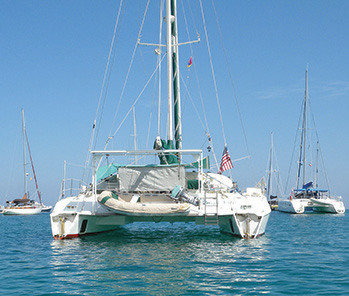 Bridgedeck Clearance Rating
Bridgedeck Clearance Rating
In order to assess bridgedeck clearance, a number of things need to be taken into account: What are the length and beam of the vessel? What is the measured bridgedeck clearance? How much of the bridgedeck is that low? Where is the minimum clearance located? How long is the bridgedeck? Is the vessel in question loaded or empty? Are the transoms submerged? How clean is the tunnel? Are there steep, flat surfaces for waves to slam into?
The “BCR” (Bridgedeck Clearance Rating) attempts to combine all these factors into one number. To help compare different vessels, you can grade them using the BCR system. A score of 1 is very poor, 10 is excellent. The steps are:
- a) Apply the bridgedeck clearance rule of thumb to calculate what bridgedeck clearance is desirable. Next, measure the bridgedeck clearance at the lowest point. Compare the two numbers and estimate an initial BCR.
- b) Study the tunnel viewed from the bows, and also the stern. Reduce your initial BCR if there are protuberances into the tunnel, and reduce more if there are flat, near-vertical surfaces for waves to slam into.
- c) Check the bridgedeck length and make further adjustment to the BCR if necessary.
I have estimated a BCR for each photo, along with comments. You now have a tool to help you compare offshore seaworthiness and comfort levels of different catamarans.

